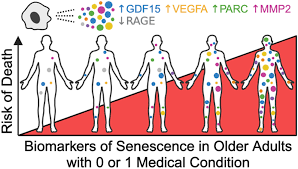Uncategorized Tuesday, 2024/01/02
As cells age, they experience aging, a state where they stop growing but continue to release inflammatory and tissue-degrading molecules. When a person is young, the immune system will respond by eliminating aging cells, commonly known as "zombie cells". However, zombie cells will continue to exist and lead to a series of age-related health problems and diseases.
In a new study, researchers from the Mayo Clinic in the United States analyzed zombie cells and explained aging at the cellular level. They thus revealed the biological characteristics of aging cells. The relevant research results have recently been published in the Journal of Aging Cell, with the title " Biomarkers of cellular senescence and risk of death in humans".

Dr. Jennifer St. Sauver, the corresponding author of the paper and the scientific director of the Mayo Clinic Population Health Scientist Program, said, "We know that different people have different rates of aging, and a person's actual age does not always match their physiological age. We found that a group of proteins secreted by zombie cells can serve as biomarkers of aging and predict the health status of the elderly. We also found that measuring these biomarkers in the blood can help predict mortality rates, not just a person's actual age, gender, or the presence of chronic diseases."
This new study included 1923 adult participants aged 65 and above who had one health condition or no health condition. These participants included 1066 females and 857 males, with 68% of the study participants having no chronic diseases and 32% having one disease. They noticed that the most common chronic diseases in this group are arthritis, high cholesterol, and a history of cancer.
Dr. Nathan LeBrasseur, senior author and director of the Mayo Clinic Aging Center, said, "The uniqueness of this new study is that biomarkers can highly predict future adverse health outcomes even in the absence of disease."
These authors found that higher levels of specific aging biomarkers, such as GDF15, VEGFA, PARC, and MMP2, are associated with an increased risk of death. Some of these biomarkers are related to the occurrence of chronic diseases. For example, studies have shown that patients with heart disease and certain types of cancer have higher levels of GDF15 and VEGFA in their bodies. The ongoing research is exploring how lifestyle factors, including diet, physical exercise, and drugs that seem to help clear aging cells, affect the circulating levels of these biomarkers.
Our Featured Products
Dr. LeBrasseur envisions using these biomarkers as tools for clinical practice to identify populations at risk of health challenges. In addition, identifying which participants are most responsive to emerging methods targeting aging cells and evaluating their response to treatment may also help identify which populations benefit from treatment.
Dr. St. Sauver emphasized the need to incorporate more diversity in future research to ensure that all populations are included in ongoing aging studies.
Dr. St. Sauver said, "We do see differences in the levels of these biomarkers between males and females, and we also know that race and ethnicity can affect many biological processes. For future research, we must consider these factors in aging studies."
Related Services
Protein Interaction Service Protein Expression and Purification Services Biomarker Service Drug Discovery Screening Protein Pathway Profiling Protein Expression Microarray
Reference Jennifer L. St. Sauver et al. Biomarkers of cellular senescence and risk of death in humans. Aging Cell, 2023, doi:10.1111/acel.14006.
